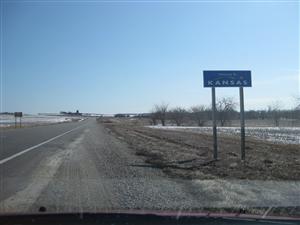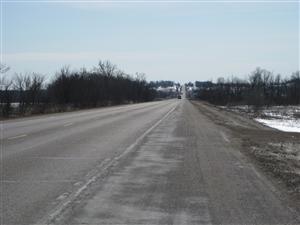The Lane Trail
Tour Stop
Directions: A historical marker [ Waypoint = ] for The Lane Trail is located in the rest area about two miles west of the junction of US Highway 36 and US Highway 75.
If you are coming from Tabor, Iowa:
- Backtrack to Interstate 29 and head south.
- After about 14 miles, take exit 10 and turn right (west) onto Iowa State Highway 2.
- After about 2.2 miles, turn left (south) onto US Highway 75.
- After about 58.2 miles, take the exit for US Highway 36 and head west towards Seneca.
- After about 2.5 miles there will be a rest area on the right. It is located at the intersection of US Highway 36 and Acorn Road (Old Highway 75).
- The historical marker is located at the entrance off US Highway 36 just before you reach Acorn Road.
If you are coming from Plattsburg, Missouri:
- Back track about 6.5 miles west to US Highway 169 and turn right to head north on US Highway 169.
- After about 18 miles, take a right onto the ramp for I-29 North.
- After 1.8 miles, take exit 46B to merge onto US Highway 36 heading west towards St. Joseph, Missouri.
- After about 56 miles there will be a rest area on the right. It is located at the intersection of US Highway 36 and Acorn Road (Old Highway 75).
- The historical marker is located at the entrance off US Highway 36 just before you reach Acorn Road.
Description: The Lane Trail originated in Iowa City, Iowa, passing through Tabor, Iowa, crossing the Missouri River at Nebraska City, Nebraska Territory, from which it turned south before ending in Topeka, Kansas Territory. The trail generally following the path of present day US Highway 75 south from Nebraska City.
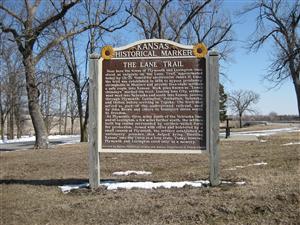
“Near here the town of Plymouth and Lexington once stood as outposts on the Lane Trail, approximated today by US-75. Named for abolitionist James H. Lane, the trail was established in 1856 to bypass proslavery strongholds in Missouri and provide free-state settlers a safe route into Kansas. Rock piles known as "Lane's chimneys" marked the trail. Leaving Iowa City, settlers went west into Nebraska and south into Kansas, passing through Plymouth, Lexington, Powhattan, Netawaka, and Holton before arriving in Topeka. The trail also served as part of the underground railroad, used by John Brown and others to transport slaves north to freedom.
At Plymouth, three miles south of the Nebraska line, and at Lexington, a few miles further south, the settlers built log cabins surrounded by earthen-walled forts for protection. Armed with rifles and bolstered by a small cannon at Plymouth, the settlers established an antislavery presence that helped bring "Bleeding Kansas" into the Union as a free state. Today, however, Plymouth and Lexington exist only as a memory.”
 James Henry Lane was the driving force behind the development of The Lane Trail. In 1855, the pro-slavery supporters in Missouri began using force to stop emigration by free-state supporters to Kansas via the Missouri River. In July of 1856, Lane was at the head of a wagon train heading west from Iowa City, Iowa. Along the way they left markers, sometimes tall poles in the tall prairie grass and other times piles of rocks. These would become known as “Lane's Chimneys.”
James Henry Lane was the driving force behind the development of The Lane Trail. In 1855, the pro-slavery supporters in Missouri began using force to stop emigration by free-state supporters to Kansas via the Missouri River. In July of 1856, Lane was at the head of a wagon train heading west from Iowa City, Iowa. Along the way they left markers, sometimes tall poles in the tall prairie grass and other times piles of rocks. These would become known as “Lane's Chimneys.”
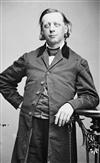 The men recruited for this trip had been promised a Sharps rifle for use in the Kansas Territory. The Sharps rifle was a breech-loading rifle known for its long range and accuracy. The rifles had gained the nickname, “Beecher's Bibles,” after the following article about Henry Ward Beecher, the abolitionist preacher, appeared in the New York Tribune on February 8, 1856:
The men recruited for this trip had been promised a Sharps rifle for use in the Kansas Territory. The Sharps rifle was a breech-loading rifle known for its long range and accuracy. The rifles had gained the nickname, “Beecher's Bibles,” after the following article about Henry Ward Beecher, the abolitionist preacher, appeared in the New York Tribune on February 8, 1856:
“[Henry W. Beecher] believed that the Sharps Rifle was a truly moral agency, and that there was more moral power in one of those instruments, so far as the slaveholders of Kansas were concerned, than in a hundred Bibles. You might just as well. . . read the Bible to Buffaloes as to those fellows who follow Atchison and Stringfellow; but they have a supreme respect for the logic that is embodied in Sharp's rifle.”
Often the crates of these rifles that were shipped to the Kansas Territory were labeled “Bibles” to mislead Federal authorities and pro-slavery militia. By the time Lane's wagon train had reached Tabor, Iowa, the recruits still had not received their rifles. They were getting restless and angry. In Tabor, Lane climbed up onto a gun carriage and gave the following speech:
“Comrades – a good soldier always grumbles. I know you have borne much already, since you left your homes. You have not always been fed on dainties, nor have you slept on down. You have endured with fortitude the perils, inconveniences, and privations of the way as good soldiers. Now you want Sharps rifles. Well, let me tell you, a Sharps rifle is a good weapon to use on an enemy at a distance, but it is good for nothing in a close encounter. If you come into a close fight (and I hope to God you may), a Sharps rifle is worthless. It is far inferior to a weapon with a bayonet. If I had my choice of arms, I would arm no more than one in ten with a Sharps rifle. As the arms you want are not here, I hope you will conclude to go on and see us through.”
His men would continue on with the wagon train as it crossed the Missouri River into Nebraska City. Jim Lane did not have the Sharps rifles, but he did have approximately 1500 rifles obtained from the Iowa state arsenal. The wagon train became known as “Lane's Army of the North.”
To provide sanctuaries along the trail, Lane directed the establishment of fortified log cabins along the trail.
The dangers facing free-state supporters emigrating to Kansas were described in a letter by Oscar E. Learnard sent to his friends in Vermont on September 9, 1856:
“You speak of a company coming from Vermont and ask concerning the proper course for them. In the first place we want nothing but fighting men in Kansas though quiet may soon be restored. They should come to Iowa City and there buy teams and come through the new road [The Lane Trail]. None should come without being well armed. Those who come will find here the most beautiful country the sun shines upon – possessing every advantage for agricultural purposes heart could wish.”
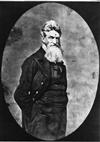 By the end of 1856, the use of the trail by immigrants heading south into Kansas had dropped off. But the use of the trail as a route on the Underground Railroad increased. Fugitive slaves escaping from Missouri, would enter into Kansas by crossing the Missouri River at Quindaro in Wyandotte County. From there the slaves would make their way to Lawrence and then follow The Lane Trail north to Nebraska. From there they would proceed to Tabor, Iowa before eventually reaching Chicago, Illinois and then on to Windsor, Ontario. In 1859, John Brown would use The Lane Trail to take 11 fugitive slaves from Missouri to Canada.
By the end of 1856, the use of the trail by immigrants heading south into Kansas had dropped off. But the use of the trail as a route on the Underground Railroad increased. Fugitive slaves escaping from Missouri, would enter into Kansas by crossing the Missouri River at Quindaro in Wyandotte County. From there the slaves would make their way to Lawrence and then follow The Lane Trail north to Nebraska. From there they would proceed to Tabor, Iowa before eventually reaching Chicago, Illinois and then on to Windsor, Ontario. In 1859, John Brown would use The Lane Trail to take 11 fugitive slaves from Missouri to Canada.
Back: The Todd House
Next: The Battle of the Spurs

